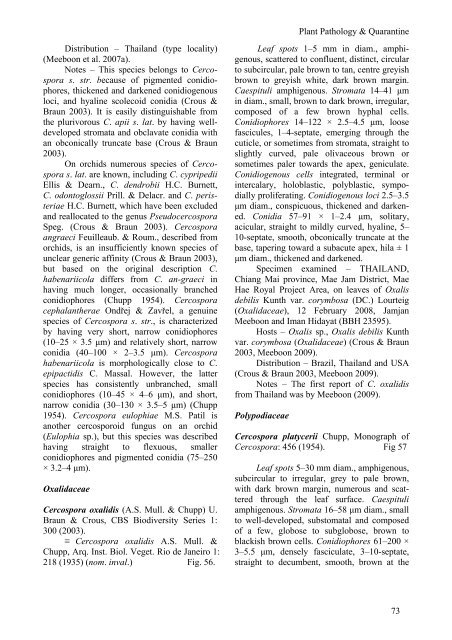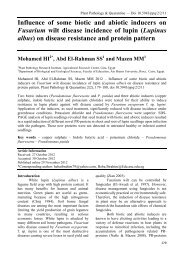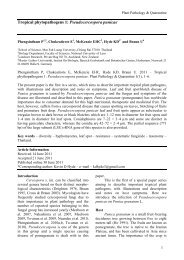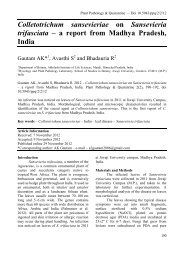Genus Cercospora in Thailand: Taxonomy and Phylogeny (with a ...
Genus Cercospora in Thailand: Taxonomy and Phylogeny (with a ...
Genus Cercospora in Thailand: Taxonomy and Phylogeny (with a ...
Create successful ePaper yourself
Turn your PDF publications into a flip-book with our unique Google optimized e-Paper software.
Distribution – <strong>Thail<strong>and</strong></strong> (type locality)<br />
(Meeboon et al. 2007a).<br />
Notes – This species belongs to <strong>Cercospora</strong><br />
s. str. because of pigmented conidiophores,<br />
thickened <strong>and</strong> darkened conidiogenous<br />
loci, <strong>and</strong> hyal<strong>in</strong>e scolecoid conidia (Crous &<br />
Braun 2003). It is easily dist<strong>in</strong>guishable from<br />
the plurivorous C. apii s. lat. by hav<strong>in</strong>g welldeveloped<br />
stromata <strong>and</strong> obclavate conidia <strong>with</strong><br />
an obconically truncate base (Crous & Braun<br />
2003).<br />
On orchids numerous species of <strong>Cercospora</strong><br />
s. lat. are known, <strong>in</strong>clud<strong>in</strong>g C. cypripedii<br />
Ellis & Dearn., C. dendrobii H.C. Burnett,<br />
C. odontoglossii Prill. & Delacr. <strong>and</strong> C. peristeriae<br />
H.C. Burnett, which have been excluded<br />
<strong>and</strong> reallocated to the genus Pseudocercospora<br />
Speg. (Crous & Braun 2003). <strong>Cercospora</strong><br />
angraeci Feuilleaub. & Roum., described from<br />
orchids, is an <strong>in</strong>sufficiently known species of<br />
unclear generic aff<strong>in</strong>ity (Crous & Braun 2003),<br />
but based on the orig<strong>in</strong>al description C.<br />
habenariicola differs from C. an-graeci <strong>in</strong><br />
hav<strong>in</strong>g much longer, occasionally branched<br />
conidiophores (Chupp 1954). <strong>Cercospora</strong><br />
cephalantherae Ondřej & Zavřel, a genu<strong>in</strong>e<br />
species of <strong>Cercospora</strong> s. str., is characterized<br />
by hav<strong>in</strong>g very short, narrow conidiophores<br />
(10–25 × 3.5 μm) <strong>and</strong> relatively short, narrow<br />
conidia (40–100 × 2–3.5 μm). <strong>Cercospora</strong><br />
habenariicola is morphologically close to C.<br />
epipactidis C. Massal. However, the latter<br />
species has consistently unbranched, small<br />
conidiophores (10–45 × 4–6 μm), <strong>and</strong> short,<br />
narrow conidia (30–130 × 3.5–5 μm) (Chupp<br />
1954). <strong>Cercospora</strong> eulophiae M.S. Patil is<br />
another cercosporoid fungus on an orchid<br />
(Eulophia sp.), but this species was described<br />
hav<strong>in</strong>g straight to flexuous, smaller<br />
conidiophores <strong>and</strong> pigmented conidia (75–250<br />
× 3.2–4 μm).<br />
Oxalidaceae<br />
<strong>Cercospora</strong> oxalidis (A.S. Mull. & Chupp) U.<br />
Braun & Crous, CBS Biodiversity Series 1:<br />
300 (2003).<br />
≡ <strong>Cercospora</strong> oxalidis A.S. Mull. &<br />
Chupp, Arq. Inst. Biol. Veget. Rio de Janeiro 1:<br />
218 (1935) (nom. <strong>in</strong>val.) Fig. 56.<br />
Plant Pathology & Quarant<strong>in</strong>e<br />
Leaf spots 1–5 mm <strong>in</strong> diam., amphigenous,<br />
scattered to confluent, dist<strong>in</strong>ct, circular<br />
to subcircular, pale brown to tan, centre greyish<br />
brown to greyish white, dark brown marg<strong>in</strong>.<br />
Caespituli amphigenous. Stromata 14–41 μm<br />
<strong>in</strong> diam., small, brown to dark brown, irregular,<br />
composed of a few brown hyphal cells.<br />
Conidiophores 14–122 × 2.5–4.5 μm, loose<br />
fascicules, 1–4-septate, emerg<strong>in</strong>g through the<br />
cuticle, or sometimes from stromata, straight to<br />
slightly curved, pale olivaceous brown or<br />
sometimes paler towards the apex, geniculate.<br />
Conidiogenous cells <strong>in</strong>tegrated, term<strong>in</strong>al or<br />
<strong>in</strong>tercalary, holoblastic, polyblastic, sympodially<br />
proliferat<strong>in</strong>g. Conidiogenous loci 2.5–3.5<br />
μm diam., conspicuous, thickened <strong>and</strong> darkened.<br />
Conidia 57–91 × 1–2.4 μm, solitary,<br />
acicular, straight to mildly curved, hyal<strong>in</strong>e, 5–<br />
10-septate, smooth, obconically truncate at the<br />
base, taper<strong>in</strong>g toward a subacute apex, hila ± 1<br />
μm diam., thickened <strong>and</strong> darkened.<br />
Specimen exam<strong>in</strong>ed – THAILAND,<br />
Chiang Mai prov<strong>in</strong>ce, Mae Jam District, Mae<br />
Hae Royal Project Area, on leaves of Oxalis<br />
debilis Kunth var. corymbosa (DC.) Lourteig<br />
(Oxalidaceae), 12 February 2008, Jamjan<br />
Meeboon <strong>and</strong> Iman Hidayat (BBH 23595).<br />
Hosts – Oxalis sp., Oxalis debilis Kunth<br />
var. corymbosa (Oxalidaceae) (Crous & Braun<br />
2003, Meeboon 2009).<br />
Distribution – Brazil, <strong>Thail<strong>and</strong></strong> <strong>and</strong> USA<br />
(Crous & Braun 2003, Meeboon 2009).<br />
Notes – The first report of C. oxalidis<br />
from <strong>Thail<strong>and</strong></strong> was by Meeboon (2009).<br />
Polypodiaceae<br />
<strong>Cercospora</strong> platycerii Chupp, Monograph of<br />
<strong>Cercospora</strong>: 456 (1954). Fig 57<br />
Leaf spots 5–30 mm diam., amphigenous,<br />
subcircular to irregular, grey to pale brown,<br />
<strong>with</strong> dark brown marg<strong>in</strong>, numerous <strong>and</strong> scattered<br />
through the leaf surface. Caespituli<br />
amphigenous. Stromata 16–58 μm diam., small<br />
to well-developed, substomatal <strong>and</strong> composed<br />
of a few, globose to subglobose, brown to<br />
blackish brown cells. Conidiophores 61–200 ×<br />
3–5.5 μm, densely fasciculate, 3–10-septate,<br />
straight to decumbent, smooth, brown at the<br />
73









